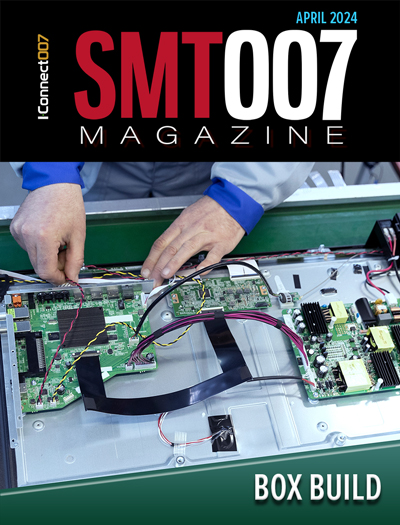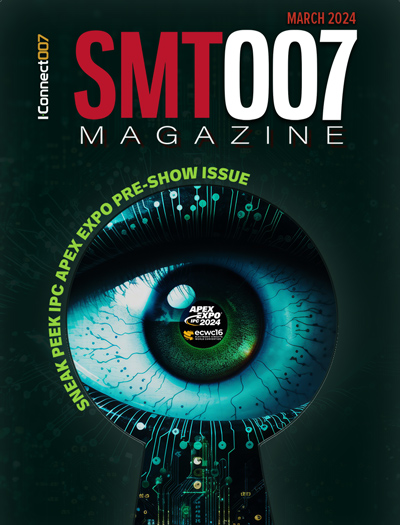-

- News
- Books
Featured Books
- smt007 Magazine
Latest Issues
Current Issue
Box Build
One trend is to add box build and final assembly to your product offering. In this issue, we explore the opportunities and risks of adding system assembly to your service portfolio.

IPC APEX EXPO 2024 Pre-show
This month’s issue devotes its pages to a comprehensive preview of the IPC APEX EXPO 2024 event. Whether your role is technical or business, if you're new-to-the-industry or seasoned veteran, you'll find value throughout this program.

Boost Your Sales
Every part of your business can be evaluated as a process, including your sales funnel. Optimizing your selling process requires a coordinated effort between marketing and sales. In this issue, industry experts in marketing and sales offer their best advice on how to boost your sales efforts.
- Articles
- Columns
Search Console
- Links
- Events
||| MENU - smt007 Magazine
eSMART Factory Conference 2019, Day 1
September 2, 2019 | Happy Holden, I-Connect007Estimated reading time: 11 minutes
I had the pleasure of attending the eSMART Factory Conference in June in Dearborn, Michigan. This is the second annual conference on the smart factory. SMTA described it as "A technical conference with a focus on electronics manufacturing from software systems/processes to augmented reality and smart inspection." It was held at the rustic Dearborn Inn across the street from the Henry Ford Museum/Village and Ford Development Center.
Trevor Galbraith, the conference chair, opened the conference and introduced the keynote speaker, Irene Petrick, Ph.D. Her keynote was titled, "Building an AI Ready Culture."
Irene Petrick is the director of Intel’s industrial innovations. Her keynote highlighted the overview of the elements of the intelligent factory, including:
- Software-defined industrial equipment and collaborative machines
- Self-organized, flexible production flow
- Self-aware production systems
- Human in the loop-enabled connected worker
- Real-time and reliable computer and connectivity
- Embedded equipment-to-equipment (E2E) security
In her talk, Petrick stated that AI has been a long time coming and may not be ready for everyone yet. But the technology underpinnings for AI are part of the strategic fit of a modern corporation and fit the competitive strategies and architectures for the future. As seen in Figure 1, the smart factory has already started. The underpinnings are currently in place, such as:
- Data collection
- Data aggregation and actions
- Data scoring, analytics, and model updates
- Business intelligence and results sharing
- Feedback to update models and achieve corrective actions
Figure 1: Opportunities for the eSmart Factory involve data collection analytics and resulting corrective actions (Source: Intel Presentation).
AI's contribution to data collection will be hindsight, insight, foresight, forecast, and act/adapt. Further, machine learning is one of the big opportunities for AI progression. The journey from unconnected machines to smart, connected machines leads to intelligent factories. In traditional machine learning, the output is known and has the least workload requirements; meanwhile, with advanced machine learning, the output is unknown and has the highest workload requirements.
Petrick shared that Intel’s own journey started in the ‘80s with wafer fabrication (hands-on) through the '90s until today’s lights-out wafer fabrication (no-hands). Intel conducted extensive interviews with industry professionals (411 participants and over 93 hours of interviews) to discover the stages the industry is today for digital usage [1]. The results included:
- Low usage (25%), medium usage (46%), and high usage (29%)
- The participants had multiple facilities in multiple countries (43%), changeovers or setups very frequent (73%), used no automation or control systems (19%), and work or support predominately discreet manufacturing processes (68%)
- Industries participating included petrochemical (27%), metal fabrication (29%), electrical equipment and components (17%), food and beverage (9%), wood and paper products (7%), and transportation (6%)
- All participants wanted the future intelligent factory
As important as machines are, automation and the smart factory is not going to replace all workers. AI must facilitate the coevolution of workers and operations. It will influence decision-makers and influencers at all levels. Foremost, it will address skill gaps and provide an understanding of gaps. It is the leaders and hardcore doers that will drive transformational changes.
In conclusion, Petrick emphasized leadership and how it’s all about data and trust. She advised the audience to think big, start small, be holistic, and be the partner of choice, which will be a competitive advantage.
The second presentation was by Michael Ford of Aegis Corporation on “How IPC Standards Are Pivotal for Industry 4.0 Achievement.” He provided a summary and report on how IPC-2581 and IPC-CFX (Connected Factory Exchange-2591) together are enabling the smart factory. Ford is chairman of the IPC-1782 Component Traceability Committee and has played a significant role in bringing CFX into fruition. CFX is the only free, open-source, consensus-based Industry 4.0 standard on the market for electronics assembly.
CFX was conceived and implemented because of numerous “standardless” interfaces being created all over the globe for electronics assembly. The dilemma that OEMs faced was a collection of different protocols that would require massive re-engineering to have a coherent operating system. Many were omnidirectional and incompatible, moving data from point to point but not achieving the real goal of Industry 4.0, which is improved productivity, profits, and quality. Thus, an IPC committee was formed to create a consistent, open solution that everyone could use. In a very short time, IPC-2591 was created with over 300 parties participating from over 100 companies around the world to produce a digital manufacturing standard suitable for “plug-and-play” connectivity. No licensing, contracts, or dependencies are required.
Page 1 of 3
Suggested Items
AIM to Highlight NC259FPA Ultrafine No Clean Solder Paste at SMTA Wisconsin Expo & Tech Forum
04/18/2024 | AIMAIM Solder, a leading global manufacturer of solder assembly materials for the electronics industry, is pleased to announce its participation in the upcoming SMTA Wisconsin Expo & Tech Forum taking place on May 7 at the Four Points by Sheraton | Milwaukee Airport, in Milwaukee, Wisconsin.
Hentec/RPS Publishes an Essential Guide to Selective Soldering Processing Tech Paper
04/17/2024 | Hentec Industries/RPS AutomationHentec Industries/RPS Automation, a leading manufacturer of selective soldering, lead tinning and solderability test equipment, announces that it has published a technical paper describing the critical process parameters that need to be optimized to ensure optimal results and guarantee the utmost in end-product quality.
Empowering Electronics Assembly: Introducing ALPHA Innolot MXE Alloy
04/16/2024 | MacDermid Alpha Electronics SolutionsIn the rapidly evolving electronics industry, where innovation drives progress, MacDermid Alpha Electronics Solutions is committed to setting a new standard. Today, we are pleased to introduce ALPHA Innolot MXE, a revolutionary alloy meticulously engineered to address the critical needs of enhanced reliability and performance in modern electronic assemblies.
New Book on Low-temperature Soldering Now Available
04/17/2024 | I-Connect007I-Connect007 is pleased to announce that The Printed Circuit Assembler’s Guide to… Low-temperature Soldering, Vol. 2, by subject matter experts at MacDermid Alpha Electronics Solutions, is now available for download.
Inkjet Solder Mask ‘Has Arrived’
04/10/2024 | Pete Starkey, I-Connect007I was delighted to be invited to attend an interactive webinar entitled “Solder Mask Coating Made Easy with Additive Manufacturing,” hosted by SUSS MicroTec Netherlands in Eindhoven. The webinar was introduced and moderated by André Bodegom, managing director at Adeon Technologies, and the speakers were Mariana Van Dam, senior product manager PCB imaging solutions at AGFA in Belgium; Ashley Steers, sales manager at Electra Polymers in the UK; and Dr. Luca Gautero, product manager at SUSS MicroTec Netherlands.


